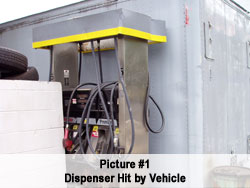Problem
This site is an active retail fueling station located in Jacksonville, Florida. On the afternoon of October 27, 2003 an automobile accident that originated on Atlantic Avenue adjacent to the facility spilled over onto the facility resulting in a pickup truck hitting a fuel dispenser, separating the dispenser from the pump island (Picture 1 & Picture 2) and rupturing the product line below grade. The station mechanic on duty witnessed the accident and immediately engaged the system emergency shut off switch. In addition, shear valves for the three lines functioned properly, which limited the amount of fuel that was released.
Solution
On October 28, 2003, TERRA-COM personnel mobilized to the referenced site to assess site conditions and to determine the appropriate scope of work necessary to clean up the spill. TERRA-COM filed the required Incident Notification (INF) with City of Jacksonville Regulatory and Environmental Services Department (RESD) at the request of the site owner.
TERRA-COM personnel installed a grid of soil borings to delineate the extent of impacted soil. The initial area of excavation was laid out on a four foot by four foot horizontal grid. This 4x4 foot area was centered just south of the pump directly adjacent to the affected dispenser sump and was excavated by hand to a depth of three feet below the bottom of the concrete surface (Picture 3). Soil samples were taken from 1-foot intervals and screened utilizing a TVA. High soil headspace readings and some product staining in this area led to the decision to expand the excavated area.
Approximately half of the pump island concrete was removed and a backhoe was brought in to aid in further excavation (Picture 4 &
Picture 5). The additional area of excavation measured approximately five feet wide, thirteen feet long, and varied between four and six feet deep. Prior to completion approximately 20 cubic yards of soil was removed from the excavation. The excavation was considered complete when all the soil headspace readings were found to be equivalent or less than the background levels at the site and all visual evidence of the product had been removed.
Upon completion of the excavation a confirmatory soil sample was taken directly beneath the line break for laboratory analysis. In addition, a sump was excavated in the bottom of the pit and allowed to fill with groundwater (Picture 6). No visual evidence or product was noted on the water. The hole was then properly backfilled and compacted and the pump island was re-built by a licensed tank contractor (Picture 7). FDEP issued a Site Rehabilitation Completion Order for this discharge on July 27, 2004.


